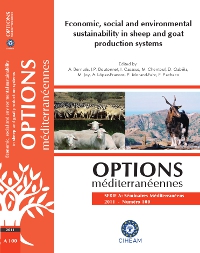| Article précédent | p. 283-288 | Article suivant |
Goat breeding systems in the South of Tunisia (Tataouine)
Goat population in Tunisia is around 1.5 million concentrated in the arid regions, mainly in the South. The local genotype (Arbi) is the most prevalent and kid meat is the main product from this breeding. Two breeding systems were identified: pastoral and agro-pastoral systems. The averages of fertility, fecundity and prolificacy were generally low (genetic characteristic of the breed) and varied between 86- 91 percent, 89-92 percent and 130-140 percent respectively. The lowest values were recorded for herds managed under pastoral systems. Kiddings are concentrated in autumn-winter. Goats are always associated with poorquality lands, with difficult access. Thus mortality of kids is often greater than 12 percent and the abortion rate usually exceeds 10 percent. The common feeding systems are grazing during the day and housing at night where supplementation with concentrate feeds is provided for lactating does. Nutrient productivity of pastoral rangelands varied between 30 and 60 UF/ha/year during favourable years (rainfall around 100 mm/year) and 10-20 UF/ha/year during dry years (rainfall < 50 mm/year). The aim of this study was to describe goat breeding systems in the South of Tunisia (Tataouine) under different climatic conditions and the possibility to ameliorate their productivity without detrimental effects on the environment.
En Tunisie, l'effectif de la population caprine est aux alentours de 1,5 million, concentré dans les régions arides du pays, et principalement au sud. La race locale est dominante, et la viande est sa production principale. Deux systèmes d'élevage ont été identifiés : système pastoral et agro-pastoral. La fertilité, fécondité et prolificité du troupeau sont faibles (caractéristique génétique de la race) et ont oscillé entre 86-89 pour cent (fertilité), 89-92 pour cent (fécondité) et 130-140 pour cent (prolificité). Les valeurs les plus faibles ont été observées dans les troupeaux conduits en système pastoral. Le chevrettage est concentré durant la période automne-hiver. Le troupeau est toujours associé à des parcours de faible qualité nutritionnelle et à accès difficile, d'où le taux de mortalité des jeunes souvent supérieur à 12 pour cent et le taux d' avortement à 10 pour cent. La supplémentation en concentré n'est disponible qu'en période critique de l'année et pour les femelles en lactation La valeur nutritionnelle varie de 30-60 UF/ha/an, durant les années pluvieuses (précipitation >100 mm/an) et de 10-20 UF/ha/an durant les années sèches (précipitations <50 mm/an). Les objectifs de cette étude sont l'identification des systèmes d'élevage caprin au sud de la Tunisie (Tataouine) et les perspectives d'amélioration de la productivité de la race sans dégrader le parcours.
- [ Afficher ]
- [ Télécharger ]
- [ Exporter la citation ]
Vous pouvez télécharger la citation au format :
- [ Imprimer ]
-
Mots-clés
CAPRIN, PARCOURS, PERFORMANCE ANIMALE, PRODUCTIVITE, SYSTEME D'ELEVAGE, TUNISIECiter cet article
Ammar H., Bodas R., Ben Younes M., López S. Goat breeding systems in the South of Tunisia (Tataouine). In : Bernués A. (ed.), Boutonnet J.P. (ed.), Casasús I. (ed.), Chentouf M. (ed.), Gabiña D. (ed.), Joy M. (ed.), López-Francos A. (ed.), Morand-Fehr P. (ed.), Pacheco F. (ed.). Economic, social and environmental sustainability in sheep and goat production systems. Zaragoza : CIHEAM / FAO / CITA-DGA, 2011. p. 283-288. (Options Méditerranéennes : Série A. Séminaires Méditerranéens; n. 100). 7. Proceedings of the International Seminar of the Sub-Network on Production Systems of the FAO-CIHEAM Inter-Regional Cooperative Research and Development Network on Sheep and Goats, 2010/11/10-12, Zaragoza (Spain). http://om.ciheam.org/om/pdf/a100/00801516.pdf



